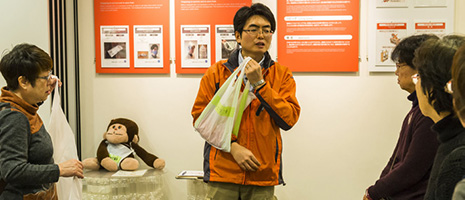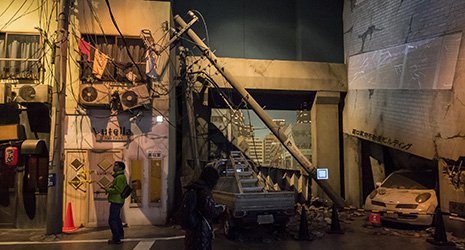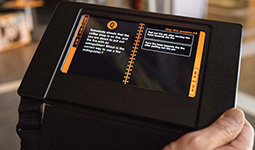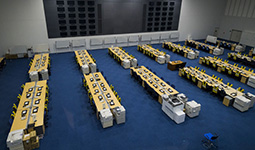Home > Highlighting JAPAN > Highlighting Japan March 2018 > Technologies for Disaster Mitigation
Highlighting JAPAN


Practicing Preparedness for Disasters
Sona Area Tokyo is a well-known disaster prevention experience learning facility in Tokyo. People visit the facility to learn and develop the skills that they will need in the event of a major earthquake or natural disaster.
In 2010, the Tokyo Rinkai Disaster Prevention Park was opened as Japan’s disaster management hub on land encompassing approximately 13 hectares in the Ariake area of Koto Ward, Tokyo. The park offers a large space that is ideal for citizens to relax in during normal times. In the event of a major earthquake or any other large-scale disaster in the Tokyo metropolitan area, the government will immediately establish Emergency Field Headquarters in the park, seeking to gather disaster information and coordinate a range of emergency measures. The park will also serve as a hub of emergency activities, including those related to medical services and rescue operations.
Disaster prevention experience learning facility Sona Area Tokyo is located in the park. It is essential that we are prepared for a natural disaster during normal times. The name Sona Area is associated with the facility’s concept of offering opportunities for people to learn skills in relation to disaster prevention preparedness (or “sonae” in Japanese).
Yoshihiro Sawa, Management Center Vice Director at the Tokyo Rinkai Disaster Prevention Park, says, “Sona Area Tokyo will serve as the government’s on-the-spot disaster control headquarters in the event of a disaster. During normal times, it serves as a facility that offers people opportunities to learn disaster prevention skills free of charge. One of the main features of the facility is that it exhibits dioramas that create an authentic representation of a disaster-hit area immediately after an earthquake.”
On the first floor of the facility, the Disaster Prevention Experience Zone offers an experience program called the Tokyo Direct-hit Earthquake 72 Hour Tour. It is often said that if a major earthquake occurred right now, it would take about 72 hours until the central or local government establishes a support system. The tour program has been designed to help people learn how to survive on their own for the 72 hours following a disaster.
The tour program begins by assuming that participants are riding in an elevator from the 10th floor of a building. Soon after the elevator starts moving, participants hear an announcement about an earthquake occurring. Participants get off the stopped elevator at the nearest floor. After getting out of the elevator, they walk through a dim maintenance corridor with no electricity and come across a diorama simulating serious damage to a city caused by a tremor of magnitude 7.3.
In the simulation diorama, participants find utility poles tilting to the ground and crumbled building walls. Products are scattered on the floor of a convenience store. Emergency vehicle sirens wail and helicopters hover overhead. Participants also see realistic live videos of the disaster with announcements in a tense atmosphere being aired on a large-screen TV installed in the street.
Participants are asked to take a quiz on a tablet device they are handed beforehand during the tour. They will answer questions asking how they would react or behave in the event of a disaster. For example, they will be asked how they should act in a convenience store in the event of a major earthquake. This study tour program has been designed to help people develop their skills to survive a major natural disaster and confirm hazards and precautions in the event of an earthquake using a tablet device.
Participants will also have an opportunity to experience staying in a small living space surrounded by cardboard partitions replicating an evacuation shelter used at the time of the Great East Japan Earthquake, along with exhibitions of emergency toilets, a bench that can be used as a furnace at the time of a disaster, and chairs made from plastic bottles in the area replicating an evacuation spot inside the park.
Besides going on the tour, people can visit the Disaster Prevention Learning Zone on the second floor of Sona Area Tokyo, where they can learn about the mechanisms of an earthquake while checking possible maximum seismic intensity and expected damage in the event of a major earthquake hitting the Tokyo Metropolitan Area. Visitors will learn how to reuse everyday items as emergency supplies, such as making a filter from plastic bottles and using a plastic bag together with newspaper as tableware. Visitors can also attend a workshop where they will learn how to make slippers from newspaper and rainwear from plastic bags.
“I came here today because I wanted to learn the skills for surviving a major disaster with my children and grandchildren. I enjoyed learning how to protect myself and survive in the event of a disaster,” says a woman who lives in Tokyo.
Sona Area Tokyo had a total of approximately 280,000 visitors in 2016. In recent years, the facility has seen growth in the number of foreign visitors, including tourists, academic researchers and government officials from about 100 countries around the world. The tablet device for the tour is currently able to be used in both Japanese and English. From April 2018, it will be able to be used in Chinese and Korean as well.
“I usually advise foreign visitors to always be prepared for a natural disaster when they travel away from home where there is a little chance of a disaster occurring, even if they live in an area that is not disaster-prone,” remarks Sawa. “I hope that our activities at Sona Area Tokyo will serve as a learning opportunity for disaster prevention for foreign visitors as well,” he adds.
With Japan’s cooperation, projects are currently underway to construct disaster prevention experience learning facilities in China and the Philippines modeled on Sona Area Tokyo. An experience facility offering opportunities to develop disaster prevention skills usually shows its true worth in the event of a disaster if it is utilized during normal times. As a nation with a long history of experiencing natural disasters, Japan can play a major role in promoting disaster prevention activities abroad.
© 2009 Cabinet Office, Government of Japan








